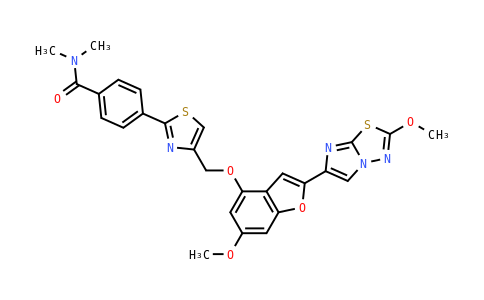1. French SL, Hamilton JR (2016) Protease-activated receptor 4: from structure to function and back again. Br J Pharmacol 173, 2952-2965.https://bpspubs.onlinelibrary.wiley.com/doi/abs/10.1111/bph.13455
2. Fender AC, Rauch BH, Geisler T et al. (2017) Protease-Activated Receptor PAR-4: An Inducible Switch between Thrombosis and Vascular Inflammation? Thromb Haemost 117, 2013-2025.https://www.ncbi.nlm.nih.gov/pubmed/29044290
3. Li S, Tarlac V, Hamilton JR (2019) Using PAR4 Inhibition as an Anti-Thrombotic Approach: Why, How, and When? International Journal of Molecular Sciences 20, 5629.https://www.mdpi.com/1422-0067/20/22/5629
4. Rohatgi T, Sedehizade F, Reymann KG et al. (2004) Protease-Activated Receptors in Neuronal Development, Neurodegeneration, and Neuroprotection: Thrombin as Signaling Molecule in the Brain. The Neuroscientist 10, 501-512.https://journals.sagepub.com/doi/abs/10.1177/1073858404269955
5. De Luca C, Colangelo AM, Alberghina L et al. (2018) Neuro-Immune Hemostasis: Homeostasis and Diseases in the Central Nervous System. Front Cell Neurosci 12, 459-459.https://www.ncbi.nlm.nih.gov/pubmed/30534057 https://www.ncbi.nlm.nih.gov/pmc/articles/PMC6275309/
6. Yin X, Wright J, Wall T et al. (2010) Brain endothelial cells synthesize neurotoxic thrombin in Alzheimer's disease. Am J Pathol 176, 1600-1606.https://www.ncbi.nlm.nih.gov/pubmed/20150433 https://www.ncbi.nlm.nih.gov/pmc/articles/PMC2843451/
7. Suo Z, Wu M, Citron BA et al. (2003) Persistent Protease-activated Receptor 4 Signaling Mediates Thrombin-induced Microglial Activation. Journal of Biological Chemistry 278, 31177-31183.http://www.jbc.org/content/278/33/31177.abstract
8. Espinosa-Parrilla Y, Gonzalez-Billault C, Fuentes E et al. (2019) Decoding the Role of Platelets and Related MicroRNAs in Aging and Neurodegenerative Disorders. Front Aging Neurosci 11, 151-151.https://www.ncbi.nlm.nih.gov/pubmed/31312134 https://www.ncbi.nlm.nih.gov/pmc/articles/PMC6614495/
9. Prodan CI, Ross ED, Vincent AS et al. (2008) Rate of progression in Alzheimer’s disease correlates with coated-platelet levels—a longitudinal study. Translational Research 152, 99-102.http://www.sciencedirect.com/science/article/pii/S1931524408001874
10. Edelstein LC, Simon LM, Lindsay CR et al. (2014) Common variants in the human platelet PAR4 thrombin receptor alter platelet function and differ by race. Blood 124, 3450-3458.https://www.ncbi.nlm.nih.gov/pubmed/25293779 https://www.ncbi.nlm.nih.gov/pmc/articles/PMC4246040/
11. Whitley MJ, Henke DM, Ghazi A et al. (2018) The protease-activated receptor 4 Ala120Thr variant alters platelet responsiveness to low-dose thrombin and protease-activated receptor 4 desensitization, and is blocked by non-competitive P2Y(12) inhibition. J Thromb Haemost 16, 2501-2514.https://www.ncbi.nlm.nih.gov/pubmed/30347494 https://www.ncbi.nlm.nih.gov/pmc/articles/PMC6289679/
12. Mao Y, Zhang M, Tuma RF et al. (2010) Deficiency of PAR4 attenuates cerebral ischemia/reperfusion injury in mice. J Cereb Blood Flow Metab 30, 1044-1052.https://www.ncbi.nlm.nih.gov/pubmed/20087365 https://www.ncbi.nlm.nih.gov/pmc/articles/PMC2949190/
13. Wong PC, Seiffert D, Bird JE et al. (2017) Blockade of protease-activated receptor-4 (PAR4) provides robust antithrombotic activity with low bleeding. Science Translational Medicine 9, eaaf5294.https://stm.sciencemag.org/content/scitransmed/9/371/eaaf5294.full.pdf
14. Wong PC, Watson CA, Bostwick J et al. (2017) Abstract 13794: An Orally-Active Small-Molecule Antagonist of the Platelet Protease-Activated Receptor-4, BMS-986141, Prevents Aeterial Thrombosis With Low Bleeding Liability in Cynomolgus Monkeys. Circulation 136, A13794-A13794.https://ahajournals.org/doi/abs/10.1161/circ.136.suppl_1.13794
15. Ismat FA, Ma X, Wang Z et al. (2016) Abstract TMP91: Phase I Assessment of the Safety, Tolerability, Pharmacokinetics and Pharmacodynamics of the Oral Protease-activated Receptor-4 Antagonist BMS-986120. Stroke 47, ATMP91-ATMP91.https://www.ahajournals.org/doi/abs/10.1161/str.47.suppl_1.tmp91
16. Wilson SJ, Ismat FA, Wang Z et al. (2018) PAR4 (Protease-Activated Receptor 4) Antagonism With BMS-986120 Inhibits Human Ex Vivo Thrombus Formation. Arterioscler Thromb Vasc Biol 38, 448-456.https://www.ncbi.nlm.nih.gov/pubmed/29269513 https://www.ncbi.nlm.nih.gov/pmc/articles/PMC5779320/
17. Casa LDC, Deaton DH, Ku DN (2015) Role of high shear rate in thrombosis. Journal of Vascular Surgery 61, 1068-1080.http://www.sciencedirect.com/science/article/pii/S0741521415000221
18. Callejo MF, Colin J, Desmeules S et al. (2016) Abstract WP263: Mutagenesis Studies Revealed Minimal Impact of Human A120T Variant of Protease-activated Receptor 4 on Receptor function or Pharmacological Response to a Potent and Selective Antagonist. Stroke 47, AWP263-AWP263.https://www.ahajournals.org/doi/abs/10.1161/str.47.suppl_1.wp263
19. Miao X, Zhang W, Huang Z et al. (2016) Unaltered Angiogenesis-Regulating Activities of Platelets in Mild Type 2 Diabetes Mellitus despite a Marked Platelet Hyperreactivity. PLOS ONE 11, e0162405.https://doi.org/10.1371/journal.pone.0162405
20. Dangwal S, Rauch BH, Gensch T et al. (2011) High Glucose Enhances Thrombin Responses via Protease-Activated Receptor-4 in Human Vascular Smooth Muscle Cells. Arterioscler Thromb Vasc Biol 31, 624-633.https://www.ahajournals.org/doi/abs/10.1161/ATVBAHA.110.219105
21. Fender AC, Kleeschulte S, Stolte S et al. (2020) Thrombin receptor PAR4 drives canonical NLRP3 inflammasome signaling in the heart. Basic Research in Cardiology 115, 10.https://doi.org/10.1007/s00395-019-0771-9
22. Rigg RA, Healy LD, Chu TT et al. (2019) Protease-activated receptor 4 activity promotes platelet granule release and platelet-leukocyte interactions. Platelets 30, 126-135.https://www.ncbi.nlm.nih.gov/pubmed/30560697 https://www.ncbi.nlm.nih.gov/pmc/articles/PMC6397092/
23. Han N, Jin K, He K et al. (2011) Protease-activated receptors in cancer: A systematic review. Oncol Lett 2, 599-608.https://www.ncbi.nlm.nih.gov/pubmed/22848234 https://www.ncbi.nlm.nih.gov/pmc/articles/PMC3406414/
24. Ma L, Perini R, McKnight W et al. (2005) Proteinase-activated receptors 1 and 4 counter-regulate endostatin and VEGF release from human platelets. Proceedings of the National Academy of Sciences of the United States of America 102, 216-220.https://www.pnas.org/content/pnas/102/1/216.full.pdf
25. Italiano JE, Jr., Richardson JL, Patel-Hett S et al. (2008) Angiogenesis is regulated by a novel mechanism: pro- and antiangiogenic proteins are organized into separate platelet alpha granules and differentially released. Blood 111, 1227-1233.https://www.ncbi.nlm.nih.gov/pubmed/17962514 https://www.ncbi.nlm.nih.gov/pmc/articles/PMC2214735/
26. Liu X, Yu J, Song S et al. (2017) Protease-activated receptor-1 (PAR-1): a promising molecular target for cancer. Oncotarget 8, 107334-107345.https://www.ncbi.nlm.nih.gov/pubmed/29291033 https://www.ncbi.nlm.nih.gov/pmc/articles/PMC5739818/
27. Zhang H, Jiang P, Zhang C et al. (2018) PAR4 overexpression promotes colorectal cancer cell proliferation and migration. Oncol Lett 16, 5745-5752.https://www.ncbi.nlm.nih.gov/pubmed/30333860 https://www.ncbi.nlm.nih.gov/pmc/articles/PMC6176407/
28. Jiang P, De Li S, Li ZG et al. (2018) The expression of protease-activated receptors in esophageal carcinoma cells: the relationship between changes in gene expression and cell proliferation, apoptosis in vitro and growing ability in vivo. Cancer Cell International 18, 81.https://doi.org/10.1186/s12935-018-0577-0
29. Sheth RA, Niekamp A, Quencer KB et al. (2017) Thrombosis in cancer patients: etiology, incidence, and management. Cardiovasc Diagn Ther 7, S178-S185.https://www.ncbi.nlm.nih.gov/pubmed/29399521 https://www.ncbi.nlm.nih.gov/pmc/articles/PMC5778519/
30. Sharma BK, Flick MJ, Palumbo JS (2019) Cancer-Associated Thrombosis: A Two-Way Street. Semin Thromb Hemost 45, 559-568.https://www.ncbi.nlm.nih.gov/pubmed/31382306
31. Holmes CE, Levis JE, Schneider DJ et al. (2016) Platelet phenotype changes associated with breast cancer and its treatment. Platelets 27, 703-711.https://doi.org/10.3109/09537104.2016.1171302

